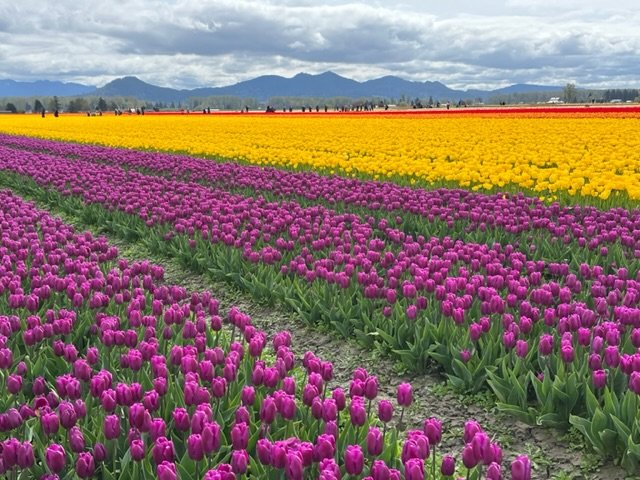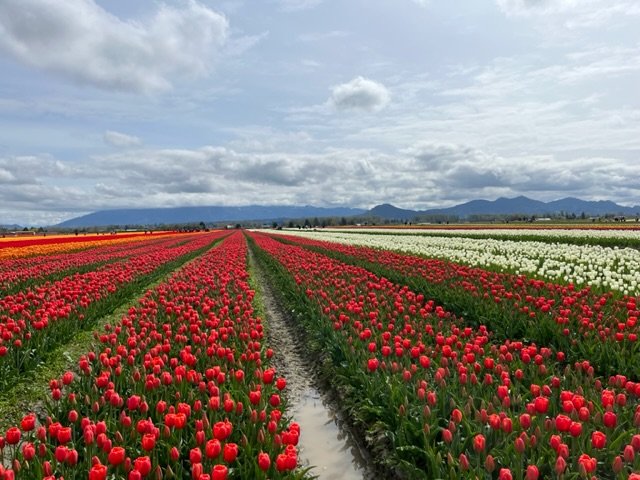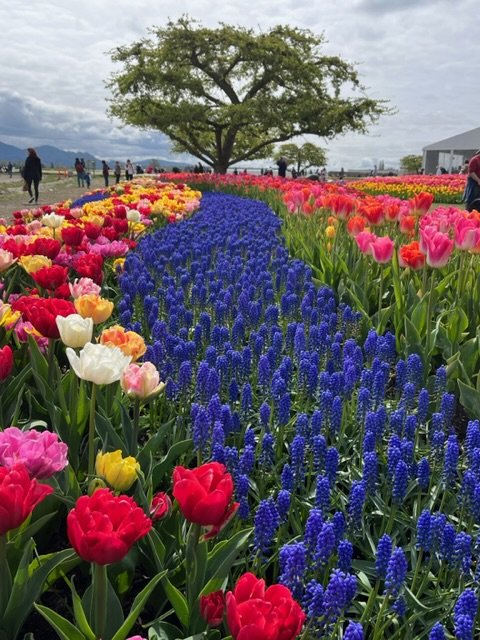The Long and Slow Unfurling of Spring
April in the Pacific Northwest is a month that can go either way— roll the dice for sun or rain. But this year feels different. It’s feels colder, wetter, longer.
We have enjoyed some glorious sunny days but they are few and far between. Winter grey has overstayed its welcome.
To some degree it feels like that every year. But especially this year. The rainy days just keep rolling in. Those teaser days of spring sunshine are elusive.
And it’s not just that I’m particularly sensitive— my tender skin having spent much of this year’s winter under the Baja sun. It really was a winter (and now spring) for the records. Talk to Californians about the snowpack, the rising rivers, mudslides and ocean surge. Here in Washington the stories of winter are told by fresh windfall crisscrossing the forest floor. The branches and downed trees surrounding our home means we are already set for firewood for the winter ahead
But the frogs are finally singing. At first a few puddle jumpers in front of my headlights at dusk. Now, it’s a chorus of deep throated voices, carried across darkness from the wetlands in the woods up to my front porch. And the smell of evening has changed. It is earthy and grassy. Steamy and musty. The smell of new life.
The daffodils jump up. Like bright stars shooting across a backdrop of green. Alder leaves, still tiny, glimmer in the breeze—bringing life to the group of creaky skeletons by the forest edge. Tender nettle greens are up by the garden fence. They look deceptively tame, even tidy. Feathery carrot sprouts, baby greens and pea shoots. The garden holds promise. The farmers market is open.
Finally, the cold, damp soil is warming up. The earth is pulsing. It finally feels like spring.
One day at a time we inch our way closer to the sun.
Plum blossoms are delicate and profuse. Apple buds are swelling. Some are opening. One warm day and the monstrous leaves of rhubarb and artichoke seem to double in size. Blueberries, roses and currants are leafing out. The tangle of grape above the pond oozes sap where I snipped a vine. Sorrel is up—thick and wavy. Chives are straight and tall. Parsley, ready to harvest.
Everyone is waking up.
And the tulips. The tulips. There is nothing quite like their compact strength and the deeply satisfying saturation of color. They are easy to forgive for showing up late.
The concert of birdsong grows louder and more complex day by day.
These changes don’t happen imperceptibly at this time of year. Magnificence seems to manifest right in front of my eyes.
It’s still cold enough in the morning for a down coat and winter hat. And in Washington there’s always a rain jacket stashed in the back of the car.
But when the rhodies flower we catch our breath. When the sun comes out it feels like we are on the glorious road to forever.
On such days I strain to imagine how that blue, blue sky could ever even hold a cloud.
I wake to a mocking drizzle, steadily drumming on the metal roof. Socked in once again. Days of grey like a weighted blanket.
Sometimes—usually between March and April—visions of a life in the tropics takes hold. The life of a snowbird starts to make sense.
The damp cold is so cold.
We make fires, we steam in the sauna. We get outside and gather with friends and family. We play games and bundle up for baseball games. We check our weather apps with both anticipation and trepidation. It’s one day at a time as the days slowly grow longer and more hopeful.
And then something happens. The pace picks up. Greens become greener. Sunny days are somehow sunnier. We leave our wool hats behind and layers become lighter. The forest is alive with chatter. It’s a rush of adrenaline as we emerge from a groggy hibernation. It’s a lightness and brightness and joy that is hard to describe. I cannot imagine a life without the intoxication of anticipation.
The slow and beautiful emergence from darkness.
I understand deeply what it would mean to miss the seasons.
We have lived in Washington State for 10 years. Every year we hear about (and see pictures of) the Skagit Valkey Tulip Festival. Every year we have intended to go.
It’s not far.
Just over an hour. North up the length Whidbey, across the bridge to Fidalgo Island, toward Anacortes then east across the Swinomish Channel. Then a quick drop south into the wide open Skagit Valley. It’s a beautiful meandering drive. Tall trees and open fields. No traffic. Along the way are glimmering glimpses of the water—sometimes on the right, sometimes the left. Holmes Harbor. Mutiny Bay. Useless Bay. The Shipping Lanes. Saratoga Passage. Penn cove, Deception Pass. Rosario Straight and Padilla Bay. So many names. So much water. Rivers flow down from the Cascades—The Snohomish, the Nooksack, the Stillaguamish, the Skagit.
The tides push in then pull back.
The ebb and flow of the Salish Sea.
Somehow, every year the month of April (when the tulips bloom) sucks us into a vortex of work and baseball and busy-ness. In the blink of an eye, ten years of missed tulip festivals are behind us.
This year is different.
Maybe it has something to do with the slowness of spring this season. A delay of the usual frenzy. Perhaps because the tulips bloomed later and longer. Whatever the reason, it was at once worth the wait and also shameful to have missed so many years of stunning beauty.
My parents came to visit and it felt like a perfect day trip on a cloudy weekday—between Dylan’s baseball games and rainstorms.
Tulips are originally native to central Asia, migrating through Turkey then making the rounds through Europe until reaching the Netherlands, where it was discovered how perfectly suited they are to the climate. Holland is renowned worldwide as a region with the soil and weather perfectly suited for growing and breeding these iconic spring flowers.
In the mid 1900’s Dutch families settling in the Skagit valley of Washington state discovered a land and climate quite similar to their native home. The waters of the Puget Sound moderate both winter weather and summer heat. Ample rainfall soaks deeply into the fertile river valley soils. A perfect recipe for tulip growers. And so it began…
Flower bulb farms stretch across the valley floor. The Cascade mountains to the east and the waters of the Salish Sea to the west are connected in this wide open space by the slow but forceful and sinuous tail of the Skagit.
Farmers in the valley grow vegetables and berries, they raise meat, produce honey and grow flowers. Tulips are a big deal. Field-grown bulbs are shipped across the globe.
There are several tulip farms in the valley. One option is a driving tour, admiring the colorful fields from a distance. Visitors can pick up maps and road-side bouquets. There are signs navigating the grid of country roads, along the “tulip route.” With a backdrop of craggy white peaks disappearing into the clouds and flower-filled fields below, it is a stunning drive. And while there is an admission charge to get up close enough to stop and smell the flowers at the larger farms, I am glad we opted to do so.
We visited Roozen Gaarde. A tulip farm that ironically means Rose Garden.
The farm, founded in 1947 by William Roozen, who emigrated from Holland, is still run by the Roozen family. Over the years the farm has grown. Fields have expanded, demonstration gardens have been developed, storage and shipping facilities have been constructed, food and gift shops added. There are parking lot attendants, picnic tables and photo opps. It’s a full blown commercial enterprise with all the tourist trappings. Somehow it still feels quaint.
The typical aversion I feel for such commercialization melted away the minute I caught glimpse of the neon rainbow stripes of stretching the horizon.
It is a beauty that might just take your breath away. It did mine.
This year the tulips brought me spring.
Without the tulips I might have been convinced that the frogs would stop singing or that the birds would change their minds and head south.
Under the seemingly endless cloud of grey I might have even been convinced that days were growing shorter not longer.
But there is something about those flowers en masse— the depth of their color, the way they open themselves up to the sky and welcome in the bees. The way they stand sturdy on their waxy silver-green stems. They are not frivolous. And they barely waver in the cool breeze.
The tulips in these fields seem to brighten up the day from below. They have me convinced that warm days are indeed ahead.
I am ready to leave the coat in the car.






















































































